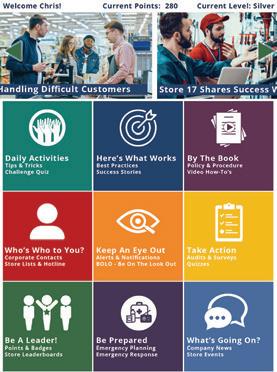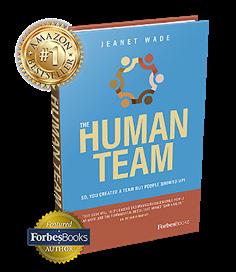
22 minute read
Certification
The Loss Prevention Foundation (LPF) is a leader in educating and certifying retail loss prevention and asset protection professionals by providing relevant, convenient, and challenging educational resources. The LPF is dedicated to elevating the industry through its accredited LPQualified and LPCertified courses. For more information, visit losspreventionfoundation.org.


Even LP Veterans Can Learn from Certification
Scott Pethuyne At this point in my career, I felt that LPC certification was the right choice to both formalize and reinforce my knowledge of the loss prevention industry. Some veteran loss prevention professionals may think certification is for someone new to the industry. It is, but it’s not exclusive to the LP novice. Individuals with ten, twenty, even thirty years of experience can benefit from the wide-ranging subjects covered especially in the LPC coursework. Here are two experienced LP professionals who recently earned their certifications with their views on why they chose to get certified, and the benefits they received.
Scott Pethuyne, LPC
Senior Analytics Solution Consultant Zebra Technologies LPCertified in April 2021
Scott Pethuyne, LPC began his career in loss prevention in 2008 working for Tween Brands as a front desk loss prevention officer. He quickly found the world of exception reporting and analytics and over the next few years moved through analyst and investigator roles, including leading asset protection analytics for Ascena Retail Group and leading asset protection analytics, operations, and safety and security for DSW/Designer Brands. In April 2020, Pethuyne made the transition to Zebra Technologies to work on the Zebra Prescriptive Analytics solution.
“At this point in my career,” said Pethuyne, “I felt that LPC certification was the right choice to both formalize and reinforce my knowledge of the loss prevention industry. I also knew that it would be a signal of my commitment and passion for loss prevention to others in the industry.”
Speaking of the LPC course, Pethuyne explained, “The LPC coursework is very thorough, clearly communicated, and detailed, but it isn’t overly burdensome. It most certainly requires a commitment from the learner that makes the certification a significant accomplishment. Anyone who is currently considering obtaining their LPC shouldn’t think twice. The LPC course provides a wealth of critical knowledge and provides the opportunity to display your commitment to the industry.”
Pethuyne had some thoughts for young LP professionals just starting out in their career. “Loss prevention professionals need to be adaptable and willing to evolve. As the world in general, and retail specifically, continues to change, LP professionals can only benefit from pursuing further education like the LPC course and looking ahead to what’s next to further their own careers as well as the interests of their employers.” Robert Sanchez, CFE, CFI, LPC
Regional Asset Protection Manager Dollar General LPCertified in June 2021
Robert Sanchez, LPC was working a civilian job with a sheriff’s department in 1994 hoping it would
Robert Sanchez It had been a while since I had taken any type of formal classes surrounding the loss prevention industry, so when
I was offered the opportunity by Dollar General to take the LPC course, it was a no brainer. continued from page 34 be a springboard into law enforcement, when he was offered the opportunity to join the asset protection team at a part-time job he was also working. Not really knowing what that meant, but assuming it would entail catching shoplifters, Sanchez took the position. Afterall, he wanted to be a police officer, so it fit right in with his plans. That job, however, led Sanchez into an AP manager-in-training role, and he never looked back. Over his twenty-seven-year career, he has held LP roles with Montgomery Ward, Tuesday Morning, PacSun, and now Dollar General.
When Sanchez was asked why he decided to pursue his LPC certification at this time in his career, he explained, “It had been a while since I had taken any type of formal classes surrounding the loss prevention industry, so when I was offered the opportunity by Dollar General to take the LPC course, it was a no brainer. There’s a saying I like that goes, ‘I am the wisest, smartest person in the world because I am the first to admit I don’t know everything.’ I think it’s important to keep challenging what you know and what you think you know. I’m smart enough to realize that I don’t know everything there is about LP, so the LPC course was the perfect fit for me.”
Sanchez added, “Things are constantly changing, especially in retail. Certification shows that you are at the forefront of understanding these changes. It shows that you are motivated to continue learning and investing in yourself and in your career. Remember, you have a unique fingerprint. One that no one before you has ever had and no one after you will ever have. Make sure you leave the best imprint possible in all you do.”
Newly Certified
Following are individuals who recently earned their certifications.
Recent LPC Recipients
Scott Boyd, LPC, LPQ, Fanatics Shane Coover, LPC, Albertsons Omar Couceiro, LPC, Target Todd Egan, LPC, At Home Stores James Harvey, LPC, Publix Scott Manley, LPC, Bealls Justin Porter, LPC, LPQ, H-E-B Florentino Posada, LPC, James Avery Craftsman Stephen Schlesing, LPC, Lowe’s Kenneth Smith, LPC, Big Lots Matthew Smith, LPC, Kittery Trading Post Fernando Vallecillo, LPC, Walgreens Tanner Webb, LPC, Bashas’
Recent LPQ Recipients
John Austin, LPQ, Target Robert Brown, LPQ, Axis Communications Kyla Burnhaueser, LPQ, Giant Food Stores Maggie Burns, LPQ, TJX Lucas Cummins, LPQ, Home Depot Chad Garbrick, LPQ, The GIANT Company Michael Graham, LPQ, Giant Martins Matthew Hausch, LPQ, Walmart Holly Hunt, LPQ, Dyson Jesus Lopez, LPQ, ALTO Dawn Louder, LPQ, Giant Martins Timothy Maldonado, LPQ, FleetPride Dillion Morningstar, LPQ, TJX Scott Rudesill, LPQ, ALTO Grant Rugar, LPQ, TJX Jose Salas, LPQ, Jacksonville Sheriff’s Office Lourdes Saldana, LPQ, ALTO Mark Sliwa, LPQ, ALTO Charles Smith, LPQ, Giant Martins Christina Strunk, LPQ, Giant Food Stores Kala Stufft, LPQ, The GIANT Company Samantha Vargas, LPQ, TJX


The Hidden Cause of Employee Theft and How to Cure It

By Jeanet Wade
There are many ways your employees can steal from you. From the “borrowing” of office supplies to overreporting of hours to embezzlement of money, divulging protected information, or selling intellectual property, there’s no one with greater opportunity to help themselves to your company assets.
And those losses, even the minor ones, add up. In fact, an article from CompareCamp that provides an astonishing mash-up of statistics on employee theft states that small thefts add up to 5 percent of revenue while inventory losses are as high as 43 percent of revenue in the US.
That doesn’t even factor in misuse of benefits, over reporting hours worked, or other fraudulent acts, such as sale of data or company information.

Curing Employee Theft
Here’s what the author said is the bottom line: “Potential global loss from fraud and employee theft is $2.9 trillion annually. It is also estimated that 33 percent of corporate bankruptcies in the US are linked to employee theft.”
Yes, you read that right. That’s trillion with a T. Every single year. And about 7,500 bankruptcies (there were 22,780 company bankruptcies reported in 2019) are caused in part or entirely by employees stealing from their employers.
I won’t quote that article further because one, you can read it yourself, and two, it gives me a headache just thinking about all the businesses being impacted by employee theft when so much of the loss could have been prevented.
Now, when I say that the loss could have been prevented, your mind probably goes to security measures, both physical and digital, and management oversight. But while those are important, and this article isn’t intended to devalue diligence and reasonable security measures, those aren’t your first line of defense in reducing loss due to occupational theft.
The first thing you need to consider when evaluating a plan for loss reduction is, believe it or not, the needs of the humans who work for your organization.
Before you shake that off as irrelevant, too vague, too undependable, too hard to measure or manage, or just too “touchy-feely” for your company culture, consider the two aspects of any crime—motive and opportunity.
Security and management oversight are focused on reducing opportunity and recovering losses. So, if someone is tempted to defraud the company, these measures may deter them, and if someone attempts a theft or succeeds in their efforts, these measures may result in apprehending the thief and mitigating the damage.
What security and oversight cannot do is address the “motive.” Motive, of course, precedes opportunity. Without motive, crimes aren’t as likely to be committed, even when opportunity presents itself.
Addressing Motive
We tend to think of motive in terms of greed, desperation, or just thoughtless pilfering. But studies show that for many employees who, when surveyed, admit to defrauding their employer, the motivation is discontent, feeling unappreciated, or simply a lack of engagement, loyalty, or connection to the company.
How many of your employees have either committed significant wrongdoing or been aware of a wrongdoing and haven’t reported it? KPMG Forensic polled 3,500 US employees for its Integrity Survey 2013 report. According to that report, 73 percent responded to that survey that in the last twelve months they had either committed or observed a serious offense.
So, what is the motivation for employees to commit crimes against their employer or look the other way when they know the company is being harmed?
In the 1940s, criminologist Donald R. Cressey studied the root causes of company fraud. He found that most of the nearly 200 convicted embezzlers interviewed stole because of financial pressure. However, he also found that there were two other determining factors for whether or not these employees went through with plans to steal from their employers: One, they had to have some belief that they were going to be able to get away with the crime, and two, they had to have a belief that their actions were justifiable.
In his book Occupational Fraud and Abuse by Joseph T. Wells, the former FBI agent and white-collar crime expert who founded the Association of Certified Fraud Examiners, published what he called the “crime triangle.” The three points in this triangle were opportunity, pressure, and rationalization.
THE FIRST THING YOU NEED
Universal Human Needs
Humans are fascinating. One thing that makes them so intriguing is their ability to hide their motives even from themselves and to create narratives to explain subconscious beliefs and emotions.
The thing is that humans have natural needs that are pretty much universal. They need to feel heard and seen, they need to have a sense of belonging, and they need to know their contributions matter. There isn’t a human alive who doesn’t have those needs. And when those needs aren’t met, we feel uncertain, insignificant, threatened, even violated. That’s because those needs are wired into our brain settings and DNA as vital to survival.
The interesting thing about this is that most of your employees don’t know they have those needs, or they believe they “shouldn’t” need these things from their teams and leaders. So they won’t tell you that their rationalization for a crime includes, “I didn’t feel like I mattered or that I belonged.” In fact, they probably don’t even realize that it’s true.
Albert Pujols, the three-time MVP who left the St. Louis Cardinals for the Angels after three World Series appearances and two World Series wins, was highly criticized for leaving his team and a town that nearly idolized him. It was widely assumed that his motivation was the hefty salary package offered by his new team.
However, years after that decision he gave an interview refuting that common perception and stating that it was the leadership of the Cardinals team that caused him to make the move. It wasn’t money, he insisted, he’d had another offer that was even higher than the Angels, and he didn’t take it either. He wanted to go where the team management appreciated him and his contribution, and he felt that was not true in St. Louis.
While this is only one anecdotal story, there are thousands of similar tales and plenty of studies that come to the same conclusion. For many people, having their human needs met is often more of a motivation than any amount of money.
Feelings and Engagement Influence Behavior
And studies show that our feelings have more to do with behavior than temptation. In an article titled “Why Employees Commit Fraud” the Journal of Accountancy summarizes one of the studies referenced in the article by saying, “The researchers concluded the most common reason employees committed fraud had little to do with opportunity, but more with motivation—the more dissatisfied the employee, the more likely he or she was to engage in criminal behavior.”
When we talk about employee satisfaction and engagement, we usually turn to Gallup’s “State of the American Workplace Report.” No matter what year’s report you happen to reference, their findings are all disheartening. Generally, you can expect to learn that only about one-third of the employees surveyed are considered engaged, about half are disengaged, and the remainder are actively disengaged.
Those actively disengaged or dissatisfied employees can be a real threat to your security and your bottom line. One Gallup report estimates that actively disengaged employees cost US companies between $450 billion to $550 billion each year in lost productivity and goes on to say about those disengaged employees, “They are more likely to steal from their companies, negatively influence their coworkers, miss workdays, and drive customers away.”
Typically, when companies make employee satisfaction, retention, productivity, or engagement a focus, they turn to nurturing activities. And they may see a temporary bump in morale, but unless there are systemic changes made in conjunction with these activities, the increase in engagement is likely to be short-lived and may even backfire.
That’s because, before we can nurture people to excellence or even engagement, we must meet their natural, universal needs as human beings. Nature—our instincts, brain function, and what Kathy Kolbe, theorist and founder behind the Kolbe Conative Assessment tool, calls “MO” or modus operandi—is at the core of our most deeply ingrained beliefs and behavioral patterns. Nurture—the activities of coaching, engagement, and motivation—cannot take root until we’ve accounted for nature.
6 Facets of Human Needs
The bridge between nature and nurture is to understand and provide what humans need in order to be fulfilled or “self-actualized” as part of a group dynamic. In my book The Human Team, I refer to these as the 6 Facets of Human Needs™. This framework allows business leaders to dependably assess their team health and create processes and structures to meet these human needs and increase employee engagement and satisfaction. The truth is that you actually have three powerful tools to keep people

Curing Employee Theft
SECURITY AND MANAGEMENT
oversight are focused on reducing opportunity and recovering losses. What security and oversight cannot do is address the “motive.” Motive, of course, precedes opportunity. Without motive, crimes aren’t as likely to be committed even when opportunity presents itself.
from even thinking about stealing from you. I call them “Connection, Consideration, and Contribution.” These are just three of the 6 Facets of Human Needs, but we’re going to focus on these, as they are most relevant to preventing the disconnection, dissatisfaction, and malcontent that often leads to occupational theft and fraud.
Remember that I said that all humans need to feel heard and seen, need to have a sense of belonging, and need to know their contributions matter? You probably nodded your head because you probably recognized those needs in yourself and the other humans around you. Well, that’s pretty much what Connection, Consideration, and Contribution are about. Here’s what happens when those needs are met and when they aren’t and some tools for using this framework to meet the needs of your teams, increase productivity, and decrease risk of employee theft and fraud.
Connection
As humans, we are basically herd animals, wired for connection and belonging to understand ourselves and to feel safe in the world.
When people feel disconnected, excluded, or alienated in a group setting, they are likely to develop a “me versus them” belief system that can easily degenerate to seeing the company as an adversary. But when they have a sense of connection, they see themselves as part of the company and identify the success of the company with their own level of success.
The effects of connection go far beyond psychology or self-reporting studies. Research on the neurological changes in the brain brought on by connection or by “othering”—the process of identifying yourself or others as part of the “in group” or the “out group”—show that the areas of the brain activated by feeling “othered” or disconnected are the same as those activated by physical pain.
On the other hand, feeling connected or part of the group resulted in an increase in oxytocin, the love hormone, or “cuddle chemical,” which bonds us to people and promotes human connection.
Meeting your teams’ need for connection is more than building personal bonds. In fact, having individuals who feel connected to some of their teammates but not to the company as a larger idea is likely to result in subgrouping, which can increase feelings of othering and lead to destructive behaviors.
To have a true sense of belonging, the humans on your team need to feel connected at several levels.
Yes, they need to feel connected to each other. They need to have a sense of community and that a win for the company is a win for all the members on the team. In order to connect with each other at that level, they also need to connect to the bigger concept of what the company stands for—the mission, values, and culture—what beliefs and ideals hold you all together.
And finally, they need to connect to the company’s place or space. In human evolution, geographic spaces were critical to belonging to the tribe, and that sense of being connected through sharing physical space is still wired into our DNA.
The truth is that most people don’t harm people or things they feel connected to or a part of. Of course, there are exceptions—desperation or disregard for others are factors that can certainly override
those norms. But you can certainly reduce the number of employees who would be able to rationalize harming the company just by increasing their level of connectedness to the company.
Contribution
One of the most important things we can do as business leaders, both in terms of creating healthy, productive teams and mitigating risks of employee theft, is to acknowledge the human psyche’s need to contribute and reward those contributions.
Have you ever found yourself sitting in a meeting, mind wandering, toes tapping, trying to figure out your purpose for being in the room or on the call? How engaged were you, and how much attention did you give to the proceedings of the meeting?
If we want healthy, engaged, loyal teams, we have to allow them to contribute at the highest level of their capability. Anything less and, as you probably noticed if you reflected on the scenario above, they begin to disengage. And that disengagement isn’t confined to the context of that single meeting.
People who feel insignificant or undervalued will either disengage, leading to lack of connection and resentment, or in their desire to be significant and a part of the project or objective will disrupt those who are currently contributing at a higher level. Either outcome leads to business loss and increased risk.
To make sure everyone feels their contributions are meaningful and valued, ask yourself the following questions: ● Is everyone on your team serving at their highest and best? ● When setting expectations,
are you achieving mutual agreement? ● Does each team member have a voice at the table?
Do you have the right voices at the table? ● Is each individual continually learning and then applying new knowledge to the team or organization? ● Does the team member feel they are contributing meaningful work? Do they like their job and/or role? ● Have you established guidelines for working as a team?
Finally, pay attention to the size of your teams. Smaller teams increase engagement and allow greater contribution from everyone included. Studies show that small-team intimacy triggers oxytocin and increases empathy. It’s probably the reason that Amazon founder Jeff Bezos goes by the two-pizza rule. If you can’t feed a team with two pizzas, he says, it’s too big. Consideration
Every human wants to be valued, and we know when we aren’t. A person who senses that they are unappreciated, inadequately compensated (and not all compensation is monetary), or treated unfairly in any way is going to be tempted, consciously or not, to balance the books so to speak.
And that’s the key to consideration, that we begin by recognizing and respecting the unique human being, that we apply the “Platinum Rule” of treating them the way they want to be treated, and that we reward contributions appropriately, which can range from a high five, a public thank you, a small gift or card, or a monetary reward, such as a raise.
When people aren’t having their need for consideration met, they feel like a “non-entity,” no more individual or important than a robot or a cog in the wheel. Their self-esteem plummets, and because, historically,
HUMANS HAVE NATURAL NEEDS
that are pretty much universal. They need to feel heard and seen, they need to have a sense of belonging, and they need to know their contributions matter. And when those needs aren’t met, we feel uncertain, insignificant, threatened, even violated.
Curing Employee Theft
ONE GALLUP REPORT
estimates that actively disengaged employees cost US companies between $450 billion to $550 billion each year in lost productivity and goes on to say about those disengaged employees, “They are more likely to steal from their companies, negatively influence their coworkers, miss workdays, and drive customers away.”
unimportant members of the tribe weren’t as likely to be protected by the tribe, their biological sense of safety is threatened.
And when our significance and survival feel threatened, it’s easy to rationalize a preemptive strike or to bond with other discontented people in the “tribe.”
To meet the need for consideration, build a culture where people are seen as unique and valuable human beings before they’re categorized for their skills and capabilities. Make sure leaders and managers are getting to know the people whose success they’re responsible for. Small gestures like knowing which baseball team someone follows or what college their kids go to will go a long way toward establishing your consideration for them as a human being.
Showing genuine consideration for the people on your teams has actually been shown to be more motivating and to build greater loyalty than even monetary incentive programs. And it’s certainly more cost effective than trying to recoup losses from employee theft, fraud, or underperformance.
The Bottom Line
When you contrast the beliefs and emotions of someone who feels connected to the people they work with, the company they work for, and the mission and values the company represents, to someone who feels disconnected or even excluded from the groups and structures in the workplace, it’s obvious that it’s easier for the employee with less sense of belonging to rationalize wrongdoing.
The same is true when you think about the employee who knows they are considered to be inherently valuable as a human being as well as an asset to the team versus someone who feels like a “plug and play” robot or a cog in the wheel.
And certainly, it’s hard not to understand that someone will be more protective of the success of the company when that success represents their own contributions and those contributions have been validated and valued.
The employee who feels disconnected or excluded, like an unimportant cog in the machine whose contributions are minimal or unappreciated, can easily rationalize looking the other way when they see unethical or even illegal behavior. And they’re more likely to rationalize committing those acts themselves.
On the other hand, the person who feels as though they belong and play a vital role in something bigger than themselves, who feels like they are seen, heard, respected, and rewarded for their contributions, actually identifies as a part of the company. They feel any harm done to the business as personal to themselves.
The bottom line is, when you put your focus on team health, risk mitigation is just a welcome byproduct.
Jeanet Wade is a Certified EOS® Implementer and the founder of the consulting firm, the Business Alchemist. As a facilitator, teacher, and coach, Wade helps companies implement the Entrepreneurial Operating System (EOS), a set of business concepts, principles, and tools that help business owners and executives run more successful businesses.
Pick a Career Not Just a Job!
Enter the exciting industry of Loss Prevention and Asset Protection ahead of the competition with LP Certification.
SM
n Loss prevention managers n College students n Store managers n Operations support roles n Anyone interested in a career in loss prevention COURSE CONTENT Course 1: The Retail Environment Course 2: Becoming a Successful Business Person Course 3: Loss Prevention Basics and Tools

POWERED BY THE LOSS PREVENTION FOUNDATION LPCERTIFIED Designed to provide advanced loss prevention education for experienced LP professionals with three years’ experience or more:
n Loss prevention management n Loss prevention executives
COURSE CONTENT Course 1: Leadership Principles Course 2: Business Principles Course 3: Loss Prevention Operations Course 4: Safety and Risk Management Course 5: Crisis Management Course 6: Supply Chain Security









